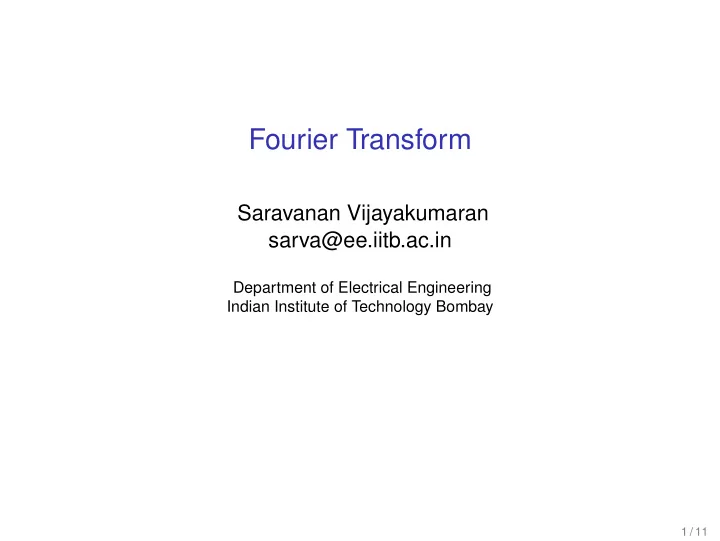

Fourier Transform Saravanan Vijayakumaran sarva@ee.iitb.ac.in Department of Electrical Engineering Indian Institute of Technology Bombay 1 / 11
Definition • Fourier transform of a signal s ( t ) � ∞ s ( t ) e − j 2 π ft dt S ( f ) = −∞ • Inverse Fourier transform � ∞ S ( f ) e j 2 π ft df s ( t ) = −∞ • Notation s ( t ) ↔ S ( f ) 2 / 11
Properties of Fourier Transform • Linearity as 1 ( t ) + bs 2 ( t ) ↔ aS 1 ( f ) + bS 2 ( f ) • Duality S ( t ) ↔ s ( − f ) • Conjugation in time corresponds to conjugation and reflection in frequency, and vice versa s ∗ ( t ) ↔ S ∗ ( − f ) s ∗ ( − t ) ↔ S ∗ ( f ) • Real-valued signals have conjugate symmetric Fourier transforms s ( t ) = s ∗ ( t ) = ⇒ S ( f ) = S ∗ ( − f ) 3 / 11
Properties of Fourier Transform • Time scaling � f � s ( at ) ↔ 1 | a | S a • Time shift s ( t − t 0 ) ↔ S ( f ) e − j 2 π ft 0 • Modulation s ( t ) e j 2 π f 0 t ↔ S ( f − f 0 ) • Convolution s 1 ( t ) ∗ s 2 ( t ) ↔ S 1 ( f ) S 2 ( f ) • Multiplication s 1 ( t ) s 2 ( t ) ↔ S 1 ( f ) ∗ S 2 ( f ) 4 / 11
Fourier Transforms using Dirac Function • DC Signal 1 ↔ δ ( f ) • Complex Exponential e j 2 π f c t ↔ δ ( f − f c ) • Sinusoidal Functions cos ( 2 π f c t ) ↔ 1 2 [ δ ( f − f c ) + δ ( f + f c )] sin ( 2 π f c t ) ↔ 1 2 j [ δ ( f − f c ) − δ ( f + f c )] 5 / 11
Properties of Fourier Transform • Parseval’s identity � ∞ � ∞ s 1 ( t ) s ∗ S 1 ( f ) S ∗ 2 ( t ) dt = 2 ( f ) df −∞ −∞ • Energy is independent of representation � ∞ � ∞ E s = � s � 2 = | s ( t ) | 2 dt = | S ( f ) | 2 df −∞ −∞ 6 / 11
Signum Function + 1 , t > 0 2 sgn ( t ) = 0 , t = 0 1 − 1 , t < 0 0 − 1 − 2 − 2 − 1 0 1 2 t Fourier Transform sgn ( t ) ↔ 1 j π f 7 / 11
Signum Function e − at , t > 0 2 a=1.5 g ( t ) = 0 , t = 0 a=0.5 1 − e at , t < 0 0 − 1 − 2 − 2 − 1 0 1 2 t sgn ( t ) = lim a → 0 + g ( t ) − j 4 π f G ( f ) = a 2 + ( 2 π f ) 2 8 / 11
Unit Step Function 1 , t > 0 1 2 u ( t ) = 2 , t = 0 0 , t < 0 1 0 − 1 − 2 − 2 − 1 0 1 2 t Fourier Transform u ( t ) = 1 2 [ sgn ( t ) + 1 ] j 2 π f + 1 1 u ( t ) ↔ 2 δ ( f ) 9 / 11
Rectangular Pulse � | t | ≤ T 2 1 , 2 I [ − T 2 ]( t ) = 2 , T | t | > T 0 , 2 1 0 − 1 − T T 2 2 t 2 T I [ − T 2 ] ( t ) ↔ T sinc ( fT ) 2 , T T 0 − T − 4 − 2 0 2 4 T T T T f 10 / 11
References • pp 13 — 14, Section 2.1, Fundamentals of Digital Communication , Upamanyu Madhow, 2008 11 / 11
Recommend
More recommend